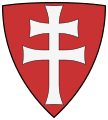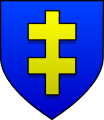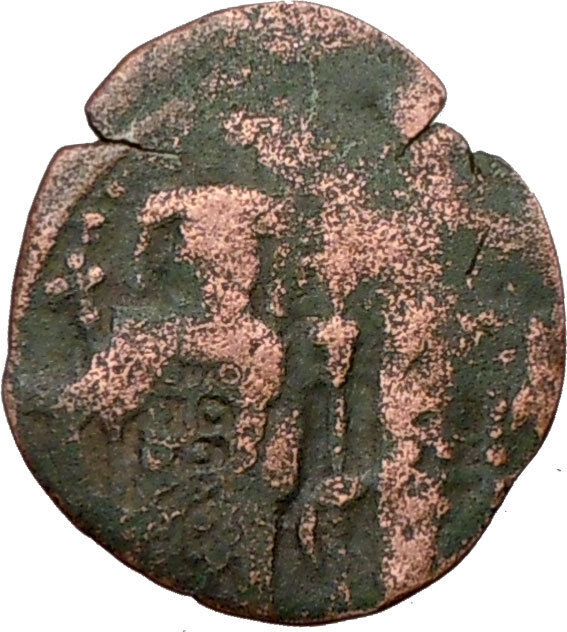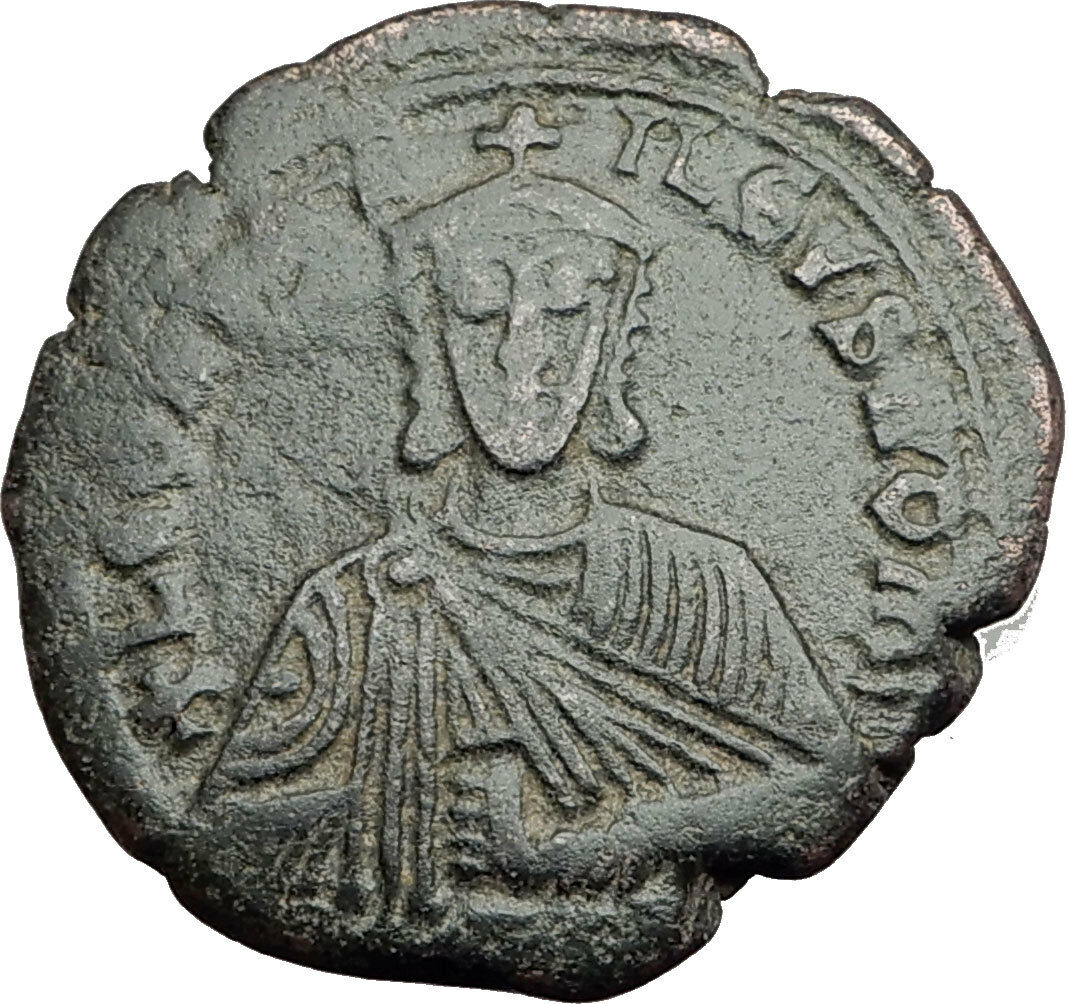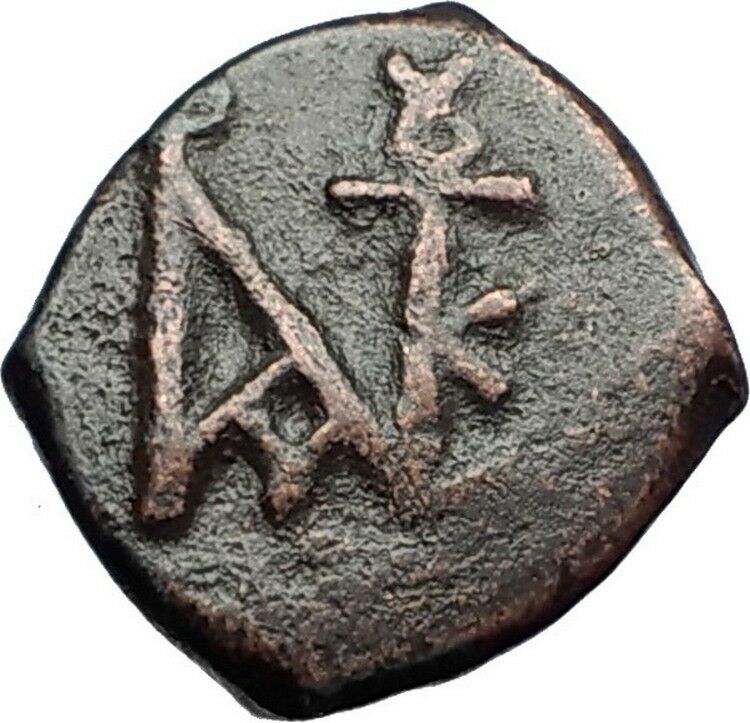|
Byzantine Empire
Anonymous Class
H
Bronze Follis 22mm (3.90
grams)
Struck during the reign of Michael VII
Emperor: October 24,1071 – March 24, 1078 A.D.
Reference: Sear 1880
Bust of Christ facing , wearing a nimbus crown, pallium and colobium, and
raising right hand in benediction;
in left hand, book of Gospels; to left, IC; to right, XC;
normal border.
Patriarchal cross, with globule and two pellets at each extremity; in lower
field, on either side, floral ornament.
For more than a century, the production of Follis denomination Byzantine coins
had religious Christian motifs which included included
Jesus Christ, and even Virgin Mary. These coins were designed to honor Christ
and recognize the subservient role of the Byzantine emperor, with many of the
reverse inscriptions translating to “Jesus Christ King of Kings” and “May Jesus
Christ Conquer”. The Follis denomination coins
were the largest bronze denomination coins issued by the Byzantine empire, and
their large size, along with the Christian motif make them a popular coin type
for collectors. This series ran from the period of Byzantine
emperors John I (969-976 A.D.) to Alexius I (1081-1118 A.D.). The accepted
classification was originally devised by Miss Margaret Thompson with her study
of these types of coins. World famous numismatic
author, David R. Sear adopted this classification system for his book entitled,
Byzantine Coins and Their Values. The references about this coin site Mr. Sear’s
book by the number that they appear in that work. The class types of coins
included
Class A1,
Class A2,
Class B,
Class C,
Class D,
Class E,
Class F,
Class G,
Class H,
Class I,
Class J,
Class K. Read more and see examples of these coins by reading the
JESUS CHRIST
Anonymous Class A-N Byzantine Follis Coins Reference.
Click here to see all the Jesus Christ Anonymous Follis coins for sale.
Click here to see all coins bearing Jesus Christ or related available for sale.
You are bidding on the exact
item pictured, provided with a Certificate of Authenticity and Lifetime
Guarantee of Authenticity.
Jesus of Nazareth (c. 5 BC/BCE – c. 30 AD/CE), also
referred to as Jesus Christ or simply Jesus, is the central figure
of
Christianity. Most
Christian denominations
venerate him as
God the
Son
incarnated
and believe that he
rose from the dead
after being
crucified
.
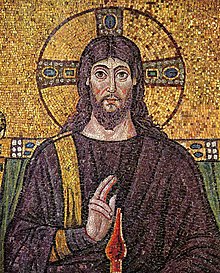
The
principal sources of information regarding Jesus are the four
canonical gospels, and most
critical scholars
find them, at least the
Synoptic Gospels, useful for reconstructing Jesus’ life and
teachings. Some scholars believe apocryphal texts such as the
Gospel of Thomas and the
Gospel according to the Hebrews
are also
relevant
.
Most critical historians agree that Jesus was a
Jew
who was regarded as a teacher and
healer
, that he
was baptized
by
John the Baptist, and
was crucified
in
Jerusalem
on the orders of the
Roman Prefect
Judaea,
Pontius Pilate, on the charge of
sedition
against the Roman Empire
. Critical Biblical scholars and
historians have offered competing descriptions of Jesus as a self-described
Messiah,
as the leader of an apocalyptic movement, as an itinerant sage, as a charismatic
healer, and as the founder of an independent religious movement. Most
contemporary scholars of the
Historical Jesus consider him to have been an independent,
charismatic founder of a Jewish restoration movement, anticipating an imminent
apocalypse. Other prominent scholars, however, contend that Jesus’ “Kingdom
of God” meant radical personal and social transformation instead of a
future apocalypse.
Christians traditionally believe that Jesus was
born of a virgin
:529–32
performed
miracles
,:358–59
founded
the Church
,
rose from the dead
, and
ascended
into
heaven,:616–20
from which he
will return
.:1091–109
Most Christian scholars today present Jesus as the awaited Messiah promised in
the
Old Testament and as God, arguing that he fulfilled many Messianic
prophecies of the Old Testament
. The majority of Christians
worship Jesus as the incarnation of God the Son, one of three divine persons of
a reject Trinitarianism
Trinity, wholly or partly,
believing it to be non-scriptural.
Michael VII Doukas or Ducas (Greek:
Μιχαήλ Ζ΄ Δούκας, Mikhaēl VII Doukas), nicknamed Parapinakēs (Παραπινάκης),
was
Byzantine emperor
from 1071 to 1078.
Life
Michael VII was the eldest son of
Constantine X Doukas
and
Eudokia Makrembolitissa
, and was born c. 1050,
in Constantinople
. He had been associated with his
father on the throne late in 1059, together with or shortly before his newly
born brother
Konstantios Doukas
. When Constantine X died in
1067, Michael VII was 17 years old and should have been able to rule by himself.
He exhibited little interest in politics, and his mother Eudokia and uncle John
Doukas governed the empire as effective regents.
On January 1, 1068, Eudokia married the general
Romanos Diogenes
, who now became senior
co-emperor alongside Michael VII, Konstantios, and another brother,
Andronikos
. When Romanos IV was defeated and
captured by Alp Arslan
of the
Seljuk Turks
at the
Battle of Manzikert
in August 1071, Michael VII
remained in the background, while the initiative was taken by his uncle
John Doukas
and his tutor
Michael Psellos
. They conspired to keep Romanos
from regaining power after his release from captivity, while he himself felt
under no obligation to honor the agreement that Romanus struck with the Sultan.
After the dispatch of Eudokia to a monastery, Michael VII was crowned again on
October 24, 1071 as senior emperor.
Although still advised by Michael Psellos and John Doukas, Michael VII became
increasingly reliant on his finance minister
Nikephoritzes
. The emperor’s chief interests,
shaped by Psellos, were in academic pursuits, and he allowed Nikephoritzes to
increase both taxation and luxury spending without properly financing the army.
As an emperor he was incompetent, and surrounded by synchophantic court
officials, he was blind to the empire collapsing around him. In dire straits,
imperial officials resorted to property confiscations and even expropriated some
of the wealth of the church. The underpaid army tended to mutiny, and the
Byzantines lost Bari
, their last possession in
Italy
, to the
Normans
of
Robert Guiscard
in 1071. Simultaneously, they
faced a serious revolt in the Balkans, where they faced an attempt for the
restoration of the
Bulgarian
state in the same year. Although this
revolt was suppressed by the general Nikephoros Bryennios, the Byzantine Empire
was unable to recover its losses in
Asia Minor
.
After Manzikert, the Byzantine government sent a new army to contain the
Seljuk Turks
under Isaac Komnenos, a brother of
the future emperor
Alexios I Komnenos
, but this army was defeated
and its commander captured in 1073. The problem was made worse by the desertion
of the Byzantines’ western mercenaries, who became the object of the next
military expedition in the area, led by the
Caesar John Doukas
. This campaign also ended in
failure and its commander was likewise captured by the enemy. The victorious
mercenaries now forced John Doukas to stand as pretender to the throne. In this
situation Michael VII’s government was forced to recognize the conquests of the
Seljuk Turks
in
Asia Minor
in 1074, and to seek their support.
A new army under Alexios Komnenos, reinforced by Seljuk troops sent by
Malik Shah I
, finally defeated the mercenaries
and captured John Doukas in 1074.
These misfortunes caused widespread dissatisfaction, exacerbated by the
devaluation of the currency, which gave the emperor his nickname Parapinakēs,
“minus a quarter”. In 1078 two generals,
Nikephoros Bryennios
and
Nikephoros Botaneiates
, simultaneously revolted
in the Balkans and Anatolia, respectively. Botaneiates gained the support of the
Seljuk Turks and first reached Constantinople. Michael VII resigned the throne
with hardly a struggle on March 31, 1078 and retired into the monastery of
Stoudios
. He later became metropolitan
archbishop of Ephesus
and died in Constantinople in c. 1090.
Usurpers
Various usurpers attempted to overthrow Michael VII or rule parts of the
empire. These included:
- Nestor – A slave of
Constantine X
, he had been promoted to the
rank of governor on the towns on the Danube. He rebelled in around 1073,
placing himself at the head of the garrisons under his command, which were
already in a state of mutiny due to an arrears in their pay. The troops were
eager to plunder the Bulgarians, and he obtained the assistance of one of
the chiefs of the Patzinaks before marching onto
Constantinople
. The rebels demanded the
dismissal of minister Nikephoritzes, but discovering that he didn’t have the
numbers to attack the capital, his troops separated into smaller parties,
and proceeded to plunder the countryside. Nestor remained with the Patzinaks,
and retreated with them beyond the
Danube
.
-
Philaretos Brachamios
-
Caesar John Doukas
-
Nikephoros Bryennios
-
Nikephoros Botaneiates
Family
Michael VII Doukas had married
Maria of Alania
, daughter of King
Bagrat IV of Georgia
. By her he had at least
one son,
Constantine Doukas
, co-emperor from c. 1075 to
1078 and from 1081 to 1087/8. He died c. 1095.
The Patriarchal cross is
a variant of the
Christian cross
, the
religious symbol
of
Christianity
. Similar to the familiar Latin
cross, the Patriarchal cross possesses a smaller crossbar placed above the
main one, so that both crossbars are near the top. Sometimes the patriarchal
cross has a short, slanted crosspiece near its foot. This slanted, lower
crosspiece often appears in
Byzantine Greek
and
Eastern European
iconography
, as well as
Eastern Orthodox
churches
.
The Byzant christianization came to the
Morava empire
in the year 863, provided at the
request of Prince Rastic
sent[1]
Byzantine Emperor
Michael III
.[2]
The symbol, often referred to as the patriarchal cross, appeared in the
Byzantine Empire
in large numbers in the 10th
century. For a long time, it was thought to have been given to
Saint Stephen
by the
pope as the symbol of the apostolic Kingdom of Hungary. The
two-barred cross is one of the main elements in the coats of arms of the Kingdom
of Hungary since 1190. It appeared during the reign of King Béla III, who was
raised in the Byzantine court. Béla was the son of Russian princess Eufrosina
Mstislavovna. The cross appears floating in the coat of arms and on the coins
from this era. In medieval Kingdom of Hungary was extended Byzantine Cyril-Methodian
and western Latin church was expanded later.[3][4]
The current coat of arms of Slovakia stems directly from the Cyril-Methodian
tradition of the 9th century. The two-barred cross in the Hungarian coat of arms
comes from the same source of Byzantine (Eastern Roman) Empire in the 12th
century.[5]
Unlike the ordinary
Christian cross
, the symbolism and meaning of
the double cross is not well understood.
Imagery
The top beam represents the plaque bearing the inscription “Jesus
of Nazareth, King of the Jews” (often abbreviated in the
Latinate
“INRI“,
and in the Greek as “INBI“).
A popular view is that the slanted bottom beam is a foot rest, however there is
no evidence of foot rests ever being used during crucifixion, and it has a
deeper meaning. The bottom beam may represent a balance of justice. Some sources
suggest that, as one of the thieves being crucified with Jesus repented of his
sin and believed in Jesus as the Messiah and was thus with Christ in
Paradise
, the other thief rejected and mocked
Jesus and therefore descended into
Hades
.
Many symbolic interpretations of the double cross have been put forth. One of
them says that the first horizontal line symbolized the secular power and the
other horizontal line the ecclesiastic power of
Byzantine emperors
.[citation
needed] Also, that the first cross bar represents
the death and the second cross the resurrection of
Jesus Christ
.
Other variations
The
Russian cross
can be considered a modified
version of the Patriarchal cross, having two smaller crossbeams, one at the top
and one near the bottom, in addition to the longer crossbeam. One suggestion is
the lower crossbeam represents the footrest (suppendaneum) to which the
feet of Jesus were nailed. In some earlier representations (and still currently
in the
Greek Church
) the crossbar near the bottom is
straight, or slanted upwards. In later Slavic and other traditions, it came to
be depicted as slanted, with the side to the viewer’s left usually being higher.
During 1577–1625 the Russian use of the cross was between the heads of the
double-headed eagle
in the
coat of arms of Russia
.
One tradition says that this comes from the idea that as
Jesus Christ
took his last breath, the bar to
which his feet were nailed broke, thus slanting to the side. Another tradition
holds that the slanted bar represents the
repentant thief
and the
unrepentant thief
that were crucified with
Christ, the one to Jesus’ right hand repenting and rising to be with God in
Paradise, and one on his left falling to Hades and separation from God. In this
manner it also reminds the viewer of the
Last Judgment
.
Still another explanation of the slanted crossbar would suggest the
Cross Saltire
, as tradition holds that the
Apostle St. Andrew
introduced
Christianity
to lands north and west of the
Black Sea
: today’s
Ukraine
,
Russia
,
Belarus
,
Moldova
, and
Romania
.
Another form of the cross was used by the
Jagiellon
dynasty in Poland. This cross now
features on the coat of arms of Lithuania, where it appears on the shield of the
knight. It is also the badge of the Lithuanian Air Force and forms the country’s
highest award for bravery, the
Order of the Cross of Vytis
.
The Patriarchal Cross appears on the
Pahonia
, used at various times as the coat of
arms of Belarus
.
-
Coat of arms of Kingdom of Hungary
under king
Béla III
-
Present-day
coat of arms of Hungary
-
-
Coat of arms of
Jagiełło
of Poland
-
Serbian
Tsar Stefan Dušan
holding the
patriarchal cross.
|






